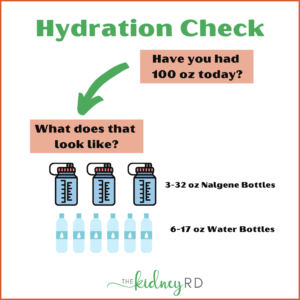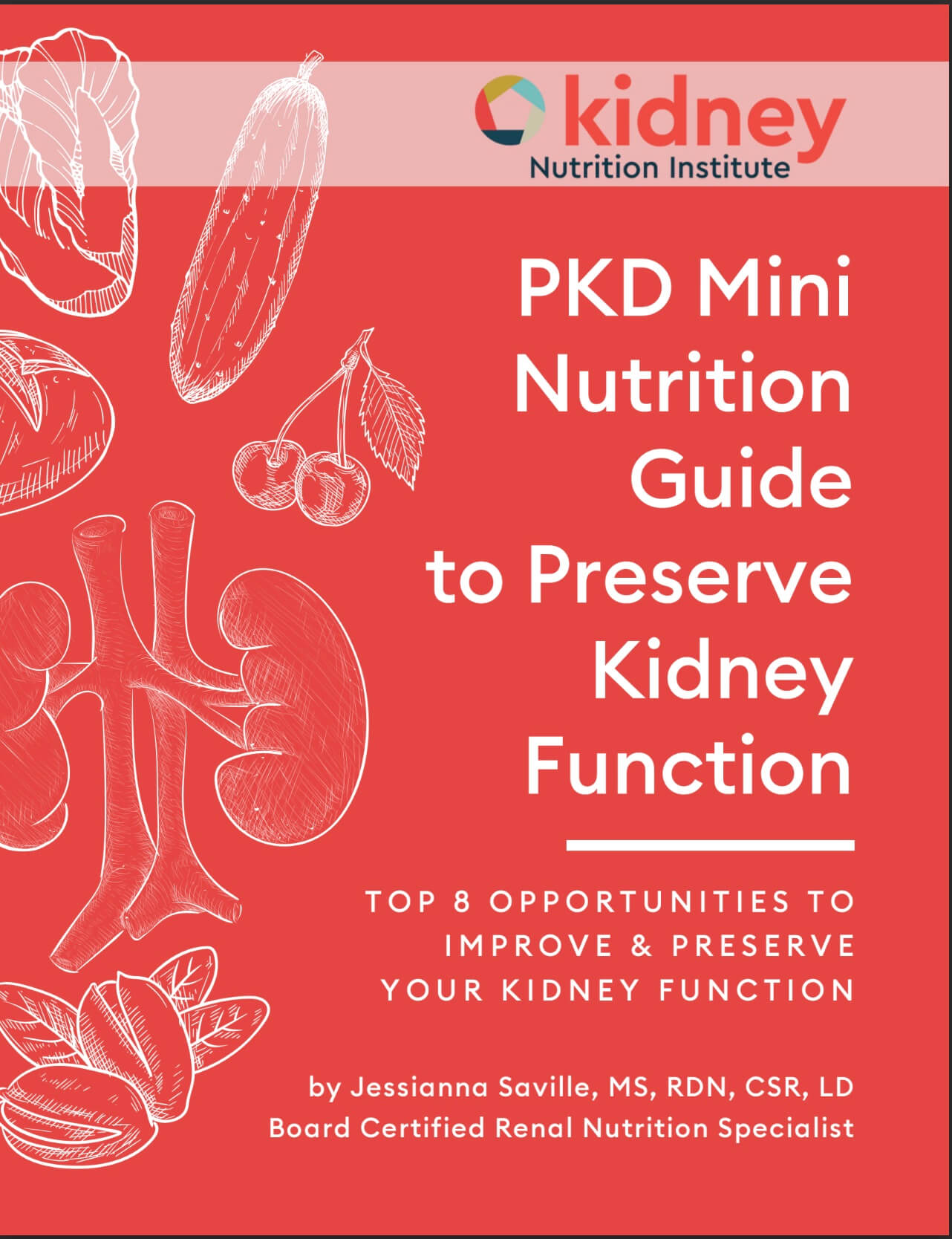During week one of Polycystic Kidney Disease (PKD) awareness month, we’re highlighting two fundamental strategies for PKD care: Sodium and Hydration.
Read on as we deep dive into both of these topics and how they play an essential role in slowing the progression of PKD.

Simplify Sodium
Sodium is an essential nutrient. That’s right, you 100% need some in your life! Too much sodium, however, can increase blood pressure (BP) and is associated with the faster progression of PKD.
The recommended maximum amount of sodium, per the American Heart Association, is 2300 mg a day. This equals 1 teaspoon of table salt. On average, Americans consume 3,400 mg or more a day. Well above and beyond the recommended intake.
For people living with kidney disease, including PKD, being mindful of sodium is an important way to take care of your kidneys! Eating too much salt can increase the risk of high blood pressure.
People with PKD are at a higher risk of developing high blood pressure. Development of hypertension (HTN) younger than 35 years old and poorly managed BP are both connected with a larger total kidney volume (TKV) and an increased risk of kidney function decline.
Where does all the sodium come from in our diets?*
According to the CDC:
- 71% comes from processed foods (think packaged, prepared, and restaurant food).
- 14% is naturally occurring
- 11% is from home cooking and salting at the table. A much smaller percentage!
*Sodium and Food Sources | cdc.gov
Sodium Tips for PKD
The best place to start with reducing your intake is to look at how much you are actually consuming! Not sure how to do that? Look at the food labels in your pantry and the items you eat frequently.
Want to learn more about food labels, check out this Nutrition Facts Label Guide. Another great resource, that looks specifically at sodium and marketing labels, is the Sodium in Your Diet Guide.
Different people have different sodium needs and factors like activity level, climate, ketogenic diet, and medications play a role in needs. Not sure what yours are? Speak with your Doctor or Dietitian to help with your nutrition and sodium plan.
A few of our favorite ways to keep salt in check!
- Check the nutrition facts label of packaged food products.
- Cook at home more often, using minimally processed whole food ingredients.
- When dining out- ask for food to be prepared with less salt. Sauces tend to be loaded with sodium. Ask for them on the side.
- Use low sodium ingredients to boost flavor without salt! Lemon, vinegar, herbs, and spices are a great way to add flavor without adding any sodium.
“NO sodium is not better than LOW sodium”! However, the benefits of lower sodium intake include improved blood pressure control, reduced risk of kidney stones, both of which can help slow the progression of ADPKD.
Fill up on fluid!
Good hydration is a big deal for PKD, there are two primary ways that it can impact cyst formation and growth:
- Inhibiting the vasopressin and cAMP pathway
- Kidney stone prevention
Vasopressin and cAMP pathway:
Altered signaling pathways, resulting from PKD gene mutations, include the regulation of cyclic adenosine monophosphate(cAMP), a messenger chemical in the body. Why is this important to know? Because cAMP promotes cyst growth by stimulating cyst production and by increasing fluid secreted into cysts.
cAMP is activated in response to a hormone called vasopressin. The vasopressin hormone is released in response to dehydration. This is a normal body process where the brain signals to the body that more fluid is needed. Vasopressin levels naturally run higher in individuals with PKD.
Therefore, increasing water intake and ensuring proper hydration is a key strategy to reduce the vasopressin and cAMP pathway to ultimately work towards inhibiting cyst growth and positively modifying the course of PKD.
Kidney stone prevention:
Kidney stones are more prevalent in people with PKD, affecting 20-30% of individuals compared to only one to two percent of the general population.
One of the easiest ways to prevent kidney stones is by increasing fluid intake! That’s because high fluid intake increases the volume and flow of urine making it easier to flush the waste products (solutes) that can develop into stones from the body.
Numerous studies have found a significant association between high fluid intake and the decreased risk of incident and recurring kidney stones.
There are many different types of kidney stones and causes. If you are a person who suffers from them, it’s important to work with your physician to identify what type of stone you are forming and the potential causes.
How much fluid is right for you?
A general recommendation is to drink at least 3 liters of fluid per day. That is equal to 12 cups or 96 ounces. More specifically, a goal of about 2.5 liters of urine output a day is ideal.

Since most of us don’t routinely measure our urine output, an easier way is to check the color of our urine. Urine that is pale yellow and almost clear is optimal. If the color is dark yellow, that’s a good indication to increase your fluid intake.
Urine can change color with new medications, a cyst infection, or a ruptured cyst. If you notice abnormal changes in your urine, contact your medical doctor for advice.
Always discuss your unique fluid needs with your Physician and Dietitian because many different factors can influence fluid requirements, including:
- exercise
- climate
- medications
- renal function status
- body size and caloric intake
Diet matters in Polycystic Kidney Disease!
Being mindful of sodium and hydration are two of the most important, yet, simple ways to manage polycystic kidney disease.
Managing blood pressure is much easier when keeping salt in check. Remember that people with PKD are at a higher risk of developing high blood pressure, and poorly managed blood pressure is associated with a faster decline of kidney function.
Staying well-hydrated is a tried and true strategy that has a two-fold benefit! Suppressing the hormone that is responsible for driving cyst growth, and decreasing the risk of kidney stones.
If you want to learn more about the science-based nutrition approach designed for people with PKD, visit the Ren.Nu PKD Nutrition program. Ready to get started? Join the waitlist for the next available program or schedule your free discovery call today!


